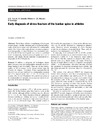Identificador persistente para citar o vincular este elemento:
https://accedacris.ulpgc.es/jspui/handle/10553/74061
| Campo DC | Valor | idioma |
|---|---|---|
| dc.contributor.author | Garcés Martín, Gerardo | en_US |
| dc.contributor.author | González-Montoro, I | en_US |
| dc.contributor.author | Rasines, J. L. | en_US |
| dc.contributor.author | Santonja, F. | en_US |
| dc.date.accessioned | 2020-08-10T08:00:21Z | - |
| dc.date.available | 2020-08-10T08:00:21Z | - |
| dc.date.issued | 1999 | en_US |
| dc.identifier.issn | 0341-2695 | en_US |
| dc.identifier.other | WoS | - |
| dc.identifier.uri | https://accedacris.ulpgc.es/handle/10553/74061 | - |
| dc.description.abstract | Thirty-three athletes complaining of back pain of more than 1 months' duration and with normal radiography of the lower spine were all studied by scintigraphy and in 24 of them with single photon emission computerized tomography. A stress fracture was considered present if localized increased uptake was seen at a vertebral level. Scintigraphy showed increased uptake in 17 of 33 patients and single photon emission computerized tomography in 16 of 24 patients. | en_US |
| dc.description.abstract | 33 athlèes se plaignant de lombalgies depuis plus d’un mois avec des radiographies normales de la colonne lombaire ont étéétudiés. Tous ont eu une scintigraphie, et 24 un scanner. A été retenu comme signe de fracture de fatigue, l’existence d’une augmentation de densitéà un niveau vertébral. La scintigraphie montrait une telle augmentation chez 17 des 33 patients et le scanner chez 16 des 24 patients. On conclut que même si la scintigraphie est normale, on ne peut pas rejeter le diagnostic de fracture de fatigue. | en_US |
| dc.language | eng | en_US |
| dc.relation.ispartof | International Orthopaedics | en_US |
| dc.source | International Orthopaedics [ISSN 0341-2695], v. 23 (4), p. 213-215, (Octubre 1999) | en_US |
| dc.subject | 321315 Traumatología | en_US |
| dc.subject.other | Low-Back-Pain | en_US |
| dc.subject.other | Pars Interarticularis | en_US |
| dc.subject.other | Spondylolysis | en_US |
| dc.subject.other | Spect | en_US |
| dc.title | Early diagnosis of stress fracture of the lumbar spine in athletes | en_US |
| dc.type | info:eu-repo/semantics/Article | en_US |
| dc.type | Article | en_US |
| dc.identifier.doi | 10.1007/s002640050353 | en_US |
| dc.identifier.isi | 000083872600006 | - |
| dc.description.lastpage | 215 | en_US |
| dc.identifier.issue | 4 | - |
| dc.description.firstpage | 213 | en_US |
| dc.relation.volume | 23 | en_US |
| dc.investigacion | Ciencias de la Salud | en_US |
| dc.type2 | Artículo | en_US |
| dc.contributor.daisngid | 34942581 | - |
| dc.contributor.daisngid | 24713408 | - |
| dc.contributor.daisngid | 10721772 | - |
| dc.contributor.daisngid | 8640672 | - |
| dc.description.numberofpages | 3 | en_US |
| dc.utils.revision | Sí | en_US |
| dc.contributor.wosstandard | WOS:Garces, GL | - |
| dc.contributor.wosstandard | WOS:Gonzalez-Montoro, I | - |
| dc.contributor.wosstandard | WOS:Rasines, JL | - |
| dc.contributor.wosstandard | WOS:Santonja, F | - |
| dc.date.coverdate | Octubre 1999 | en_US |
| dc.identifier.ulpgc | Sí | es |
| dc.description.jcr | 0,378 | |
| dc.description.jcrq | Q4 | |
| dc.description.scie | SCIE | |
| item.fulltext | Con texto completo | - |
| item.grantfulltext | open | - |
| crisitem.author.dept | GIR Biomaterials and Biomechanics Research Group | - |
| crisitem.author.dept | Departamento de Ciencias Médicas y Quirúrgicas | - |
| crisitem.author.orcid | 0000-0003-4494-9077 | - |
| crisitem.author.parentorg | Departamento de Ingeniería Mecánica | - |
| crisitem.author.fullName | Garcés Martín, Gerardo | - |
| Colección: | Artículos | |
Citas de WEB OF SCIENCETM
Citations
8
actualizado el 08-jun-2025
Visitas
123
actualizado el 23-nov-2024
Descargas
196
actualizado el 23-nov-2024
Google ScholarTM
Verifica
Altmetric
Comparte
Exporta metadatos
Los elementos en ULPGC accedaCRIS están protegidos por derechos de autor con todos los derechos reservados, a menos que se indique lo contrario.
